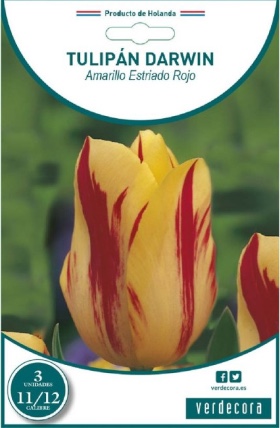5 curiosities of the tulip that, perhaps, you do not know


It is not only one of the most popular flowers, due to its beauty and variety of colors, or one of the essential bulbs to plant in October for any gardening lover. Actually, it is enough to know the curiosities of the tulip to get an idea of the historical magnitude of this beautiful and simple flower. And yes: you read correctly. Because, despite the fact that for us this flower is just one more in the garden, for our ancestors it was an obscure object of desire capable of being equated in price with a home.
Although we might think that the rose is the most famous flower in the world, it really is not. Although it is the third most commercialized flower in the world, the tulip has led the ranking of the most desired plants for several centuries, to the point that it is estimated that there are more than 12,000 hectares dedicated to the cultivation of these bulbs in the world. And let’s go with something that, although it is not part of the list of curiosities of the tulip, is very surprising: despite its fame, the Netherlands is not the only region in the world dedicated to them. Turkey, France and some African countries are also producers with an important weight in the market of this incredible flowering plant.
So let’s discover those curiosities of the tulip that make this plant, with more than 5,000 varieties, an object of desire both planted and in bouquets.
CURIOSITIES OF THE TULIP THAT IS WORTH KNOWING
Both for its beauty and its versatility, the tulip is one of the most common flower bulbs in gardens and pots. What’s more: it is also postulated in the list of the best plants for rockeries due to the ease of its care and its spectacular color. But let’s leave practical issues aside because, beyond them, it is worth understanding the magnitude of that flower that we enjoy without even knowing that the meaning of tulips according to color varies substantially in its symbology.
Perhaps this detail does not surprise us; but knowing that she is the protagonist of stories, poems and legends throughout the world may do it. Something that gives us a clue as to the extent to which it has a specific weight in the world of plants.
1. It is a perfectly symmetrical flower, one of the most peculiar curiosities of the tulip
A priori when we see flowers, we do not usually pay much attention to the arrangement of their petals. It is more: we could say, only, if they have many or few. However, the next time you see a tulip, check out something extremely unique: it is a symmetrical flower.

Except for varieties with only two, a tulip flower is made up of three petals and three sepals which, being the same size and shape as the first, also pass through petals.
2. It was the cause of “Tulipomania”, the only economic bubble caused by a flower
Also historically called “tulip fever”. Incredible as it may seem, this wonderful plant was the cause of one of the most important economic crises in the Netherlands. A consequence of speculation, which came to put the country in serious trouble and caused the price of a single bulb to be 10 times more than the average annual salary at that time.
To understand this episode it is essential to understand the context. The passion unleashed by these plants caused the producers to sell bulbs that were still underground, acquiring the buyers the rights to the plants. A system that caused a geometric growth in the price of tulips in just a few months. The bubble burst when, in 1637, the weather ruined the tulip bulb crop, causing the Dutch economy to nearly go bankrupt.
3. They were food during World War II, a curiosity of the tulip that you surely did not know
Although it is not customary in our culture, tulips are recurrent as a substitute for onion in a good number of dishes from England and Holland. What’s more: there are countries where tulip flowers are used to make wine.
And it is that, although we do not know it, a good part of them are edible. An aspect that saved a good number of Dutch people from starvation during the last great war, who found a source of food in the bulbs of the plantations abandoned by the conflict.
4. Flamed tulips are the result of a virus
Talking about signs of disease in plants is always synonymous with concern. And, logically, tulips are not exempt from it. However, it is surprising to know that one of the most demanded types of tulip for centuries was nothing more than diseased tulips. They are called flamed, marked by one characteristic: the color of their petals and sepals is not uniform, but instead presents vertical stripes or forms similar to feathers or colorless flames.

Despite their exoticism and being the most coveted, it was Dorothy Cayley who, in 1928, took away all the beauty of these plants. As well as a horticulturist, Cayley was a mycologist. And her discovery could not have been more surprising: this lack of coloration of the petals was the result of the infection of a virus that, after infecting the virus, blocks the uniformity of color in petals and sepals.
Far from being a lesser evil, this virus not only causes such decorative finishes. It actually causes the bulb to atrophy and weaken until it dies; thus ending his genetic line. And what is the most surprising thing about what is one of the most unique tulip curiosities? That a good number of tulips affected by the virus survived and still survive, without the plant presenting any alteration beyond the pattern of its flower.
5. Blue does not exist and black is scarce
Another of the curiosities of the tulip that does not go unnoticed. Although it is possible to enjoy this flower in an incredible range of colors, there is one in which we simply will never be able to see it naturally: blue.
But it is not the only color that is a rarity. Despite the huge number of existing varieties, when it comes to the black tulip the number is dramatically reduced: there are only 10 in the whole world.
Now that you know these curiosities of the tulip, we are sure that the next time you see one you will see it for what it is: a gift of nature with a unique weight in the history of humanity.



![Photo of Rose Cuttings: [Concept, Season, Rooting and Planting]](https://www.complete-gardening.com/wp-content/uploads/2022/08/rose-cuttings-concept-season-rooting-and-planting-390x220.jpg)
